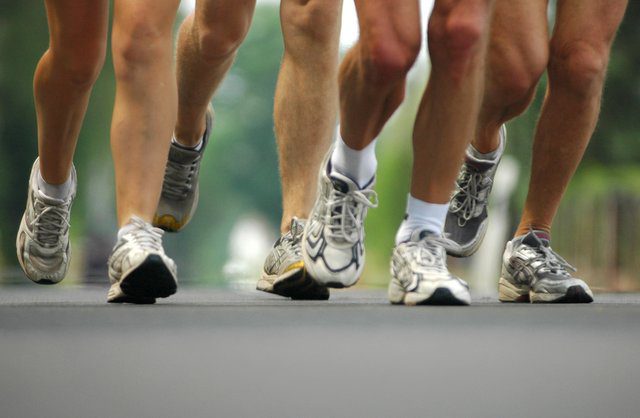By Mark Lewis
LocalSportsJournal.com
I don’t need to tell you that it’s hot outside.
Whenever the thermometer starts kissing the 80s, we Michiganders, right on cue, begin retreating into cooler environs (read: air conditioned).
So imagine what it is like for those of us who have miles to get in every week, whether they be on foot or on bike.
I remember once, during a similar heat wave as we are having this week, beginning a run with a sweat. I mean, I hadn’t even began the run and I was already drenched. As I turned a corner, about a mile into the run, a fellow was watering his lawn. I ran past and tipped my head at him. His response? He just shook his head in my direction, indicating he believed I was three cans short of a six-pack.
And he may be right.
However, I’m not that stupid. That is, even I have my limits.
Here are a few of my rules of thumb regarding exercising in extreme weather:
* Check the thermometer – I don’t run If the temperature is above 85 degrees or below 15 degrees.
For the latter, I have found that my body temperature climbs too high too fast when it is warmer than 85. If enough of the run is in direct sunlight, and if sweat comes quickly and profusely, one risks heat stroke. Seriously, it can get so hot out there that your body races past safe levels, making it nearly impossible to cool yourself. This can be especially dangerous if you’re far from home, locked into a long run. Often overheating comes on quickly and with little warning. If you find yourself suddenly overcome with heat, get some water, find some shade and relax until you return to baseline. Once you again feel normal, don’t test fate by continuing your activity; get inside and call it a day.
Ironically, overheating can be a problem in cold weather as well. Oftentimes, people over dress in cold weather, making it difficult to cool down. Further, once you start sweating in cold weather, and, as a result, your clothes get drenched with sweat, hypothermia can become a real problem.
Remember, sweating is your body’s effort to cool itself, and once you get that ball rolling in cool weather, it can start a positive feedback loop that results in a very cold and very wet runner. It’s better to use thin layers that you can take off if you start to overheat. Same with materials: winter running in cotton or wool is foolish. Opt for lighter synthetic materials that dry quickly and deal better with heat build up.
Mainly, the reason I do not run in temps lower than 15 degrees isn’t because I can’t keep myself warm. Instead, I find that once things get colder than 20 degrees, the air becomes too cold to run comfortably. That is, too cool air can do a number on your lungs, making even a short, light run a painful event. Don’t get me wrong, winter trail running is one the most satisfying things around. Nevertheless, know when it is safer to stay inside.
* Stay hydrated, but not too hydrated – It’s funny to think that coaches once thought athletes shouldn’t consume water during workouts. Lots of old-timers have regaled me with tales of tough-as-nails coaches who made their charges wait us long as two hours before allowing them to get a drink, even during summer conditioning.
Then the pendulum swung the other way. Coaches, fearing their athletes would drop dead from overheating and lack of water, broke up the rhythm of practice every few minutes to implore their athletes to get a drink. I often remember water sloshing around my stomach during my football days, slowing me up and making my performance suffer. The thing is, once I started drinking from the community faucet, I often found it difficult to stop.
Many times, I felt like I’d actually gained weight during a workout.
Come to find out, maybe I was gaining weight. We now know a lot more about a condition called hyponatremia, which is the opposite of dehydration. That is, one can drink so much water during a workout that their blood can become diluted, and making it difficult for your body to expel fluids. In extreme situations, the blood’s balance between water and sodium becomes so out of wack that athletes risk seizure, coma and, perhaps death.
The rule here is to remain sensible. If you know you will in the near future be asking a lot of your body, make hydrating a priority. Same for recovering from workouts; make sure you replace the fluids you just lost. During practice or a game, take drinks when your thirsty (which is also humorous, because the prevailing wisdom when I was a kid was if you waited until you are thirsty, you had waited too long).
Another good tip is to mix up your fluids. Water is good, but it does not replace many of the minerals necessary to replenish what you lose during a workout. Sports drinks work, but so do fruits and vegetables and even a small supply of foods like chips and cookies (items you will often find at marathon support stations).
* Use your head – Listen, I know you’re tough; so am I. But none of us is so tough to overcome a total body meltdown. I remember once listening to an episode about running on the fantastic National Public Radio program Radiolab. One of the stories was about a runner who, uhm, evacuated her bowels (on national television, no less) attempting to finish the famed Ironman triathlon. While I certainly respect the woman’s toughness and determination, I suggest you save such displays of perseverance to the very rare occurrence.
Know your limits, and stick to those limits, especially in extreme conditions.
No one wants to disrupt their running and exercise regiments because of hot or cold weather. Yet, it’s important to balance your drive to stay on schedule with the need to stay safe.
Remember, there will be no schedule to maintain if you fail to make it back from an event which takes place in extreme weather. Using your head, and following a couple sensible principles will ensure you stay safe and active.
Mark Lewis is a contributing writer for the Local Sports Journal who has covered Muskegon area sports for more than 10 years. A standout hurdler in high school, he began running again eight years ago. He completed his first marathon in 2009, and last fall participated in a 100k race in Hell, MI.






